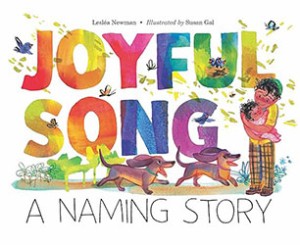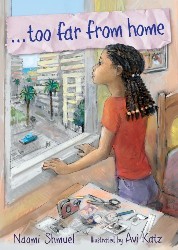Most parents are aware of the category of books dedicated to preparing older children for a new baby. Many focus on potential feelings of disappointment and exclusion as the younger sibling seems to take over the time and attention of caregivers. My Sister Is Sleeping takes a different approach, presenting a little girl so absorbed in her artwork that the arrival of a sister has no negative effect on her happy moments of drawing. The book also teaches Hebrew words in an unobtrusive way suggesting that bilingualism is a natural state and a wonderful way to express love. Young readers will relate to the fact that the girl’s identity as an artist is not compromised, but rather enhanced, by the addition to her family.
The text is gentle and poetic. Sentences in English include Hebrew words highlighted in light red font, bringing them to readers’ attention without disrupting the fluency of the story: “My little sister, achoti, is sleeping.” Busheri’s use of metaphor is consistent with a child’s perception of the world, where lips are “strawberries, tootim,” and a baby’s delicate eyelashes are “tiny feathers.” The girl is totally engaged in drawing pictures but also aware of the parallel events surrounding her as she helps care for the baby and watches her while she sleeps. Busheri subtly assures children that welcoming a new sibling allows them to show growth and maturity.
Kichka’s portraits of the young artist, a redhead with oversized glasses, are both playful and touching. She alters proportions, with some pictures reflecting a child’s perspective on her environment. Drawing at the kitchen table, the girl holds a pencil as long as her arm and produces a smiling face with a strawberry at its center, too large to be contained by the table. Settings are slanted, sometimes viewed from above, and full-color alternates with figures drawn in shades of grey. The young artist does not separate her creative role from her nurturing one. In one scene, she busily draws under a table, a large pot and spoon at her side, while her baby sister appears in the doorway sleeping in her crib. Adults will find humor in the juxtaposition of pencil and cooking utensils: “Mommy will give me a bowl and spoon, k’arah v’kapit, and I will feed her oatmeal.”
The book’s words and pictures complement one another, as simple, brief statements accompany appealingly messy settings. A balcony has a clutter of green plants and clothes hanging to dry; the girls’ room is a clutter of toys, open drawers, and brushes. A collection of stuffed animals, falling out of the baby’s crib, observes the artist at work, painting while her sister sleeps.
In this highly recommended story, Busheri and Kichka have envisioned the arrival of a baby through the eyes of an older child, one whose imagination makes her open to change.
Emily Schneider writes about literature, feminism, and culture for Tablet, The Forward, The Horn Book, and other publications, and writes about children’s books on her blog. She has a Ph.D. in Romance Languages and Literatures.





